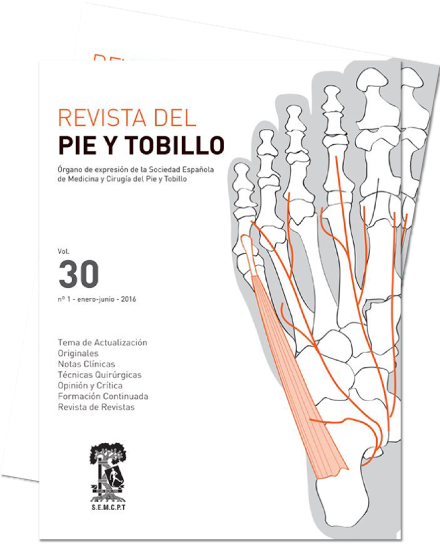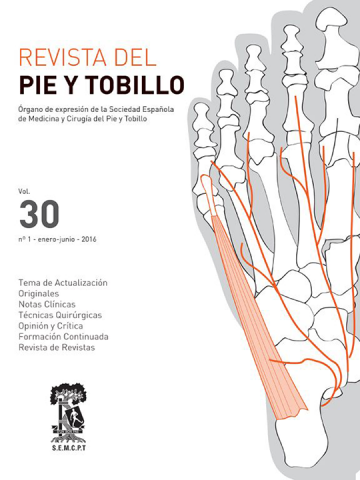Resumen:
Introducción y objetivos
La braquimetatarsia se define como el acortamiento anormal de uno a varios metatarsianos. Varias técnicas se han descrito para su tratamiento. El objetivo de este estudio es presentar nuestra experiencia en el tratamiento de la braquimetatarsia mediante osteogénesis a distracción con fijador externo, analizar sus resultados y complicaciones.
Material y métodos
Entre mayo de 2009 a enero 2015 7 pacientes (8 pies) entre 8-18 años, con diagnóstico de braquimetatarsia, fueron operados mediante osteogénesis a distracción con fijador externo. La distribución por metatarsiano alargado fue: M4 (4 pacientes), M3 (un paciente), M2 (un paciente), M1 (alargamiento bilateral en un paciente con síndrome de Pfeiffer). En 3 pacientes se realizó corrección concomitante de HAV mediante osteotomía Chevron (2 casos) y percutánea (un caso). Se realizó en todos los pacientes osteotomía percutánea del metatarsiano y capsulotomía dorsal metatarsofalángica y tenotomía de extensores con alargamiento del metatarsiano con fijador externo a un ritmo de 0,5mm/día. Describimos la técnica operatoria y nuestro protocolo posoperatorio. Se valoran los resultados postoperatorios mediante criterios radiográficos (alargamiento conseguido, porcentaje de alargamiento, índice de curación), escala AOFAS y complicaciones.
Resultados
El 90% de los pacientes estaba satisfecho con el aspecto estético, la longitud conseguida y el alivio de los síntomas. El alargamiento medio fue de 21mm (17-31mm). El porcentaje de alargamiento fue del 46,1% (30,2-81,5%). El índice de curación medio fue de 71,2 días/cm (51,9-95,7 días/cm). La puntuación media AOFAS fue de 90,5 (80-100). La complicación más frecuente fue la rigidez MF (3 casos), que precisaron tratamiento rehabilitador y artrólisis a la hora de retirar el fijador. Encontramos también una fractura del regenerado, una infección superficial y un retardo de consolidación.
Conclusión
La osteogénesis a distracción en la braquimetatarsia es un procedimiento adecuado para pacientes pediátricos y adolescentes. Evita las complicaciones neurovasculares derivadas de alargamientos agudos. Si bien la rigidez MF debe ser evitada para obtener resultados satisfactorios.
Abstract:
Introducion and objectives
Brachymetatarsia is defined as the abnormal shortening of one or more metatarsals. Several surgical techniques had been described for its treatment. The aim of this study is to present our experience in the treatment of brachymetatarsia with distraction osteogenesis with external fixator, as well as to analyse the results and its complications.
Material and methods
Between May 2009 and January 2015, 7 patients (8 feet) aged from 8 to 18 years, diagnosed with brachymetatarsia, underwent surgery based on distraction osteogenesis with external fixator. The lengthening was performed in metatarsal 4 (M4) (4 feet), M3 (1 foot), M2 (1 foot), and M1 (bilateral lengthening in a patient affected by Pfeiffer syndrome). Surgery for concomitant hallux valgus was carried out in 3 patients (2 Chevron osteotomies and 1 percutaneous correction). All patients underwent percutaneous osteotomy of the affected metatarsal, dorsal percutaneous metatarsophalangeal joint (MPJ) capsulotomy and extensor tenotomy and metatarsal lengthening with external fixator in a 0.5mm daily rhythm. Step by step surgical technique and postoperative care are described. Results are measured with postoperative x-rays (final lengthening, percentage of lengthening, healing index), American Orthopaedic Foot and Ankle Society (AOFAS) scale, and complications.
Results
The large majority (90%) of patients were satisfied with the cosmetic appearance, the final lengthening, and the relief of symptoms. The mean lengthening was 21mm (17-31mm), and the mean percentage of lengthening was 46.1% (30.2-81.5%). The mean healing index was 71.2 day/cm (51.9-95.7 day/cm). The mean AOFAS score was 90.5 (80-100). Stiffness was the most common complications, occurring in 3 patients who needed physical therapy and arthrolysis at the time of removing the fixator. There was 1 fracture of the lengthened bone, 1 superficial infection, and 1 delay in healing.
Conclusions
Distraction osteogenesis is a safe procedure for treating brachymetatarsia in the paediatric and adolescent population. It can avoid the iatrogenic neurovascular complications described in one-staged lengthening. However MPJ stiffness must be avoided in order to get an excellent result.




